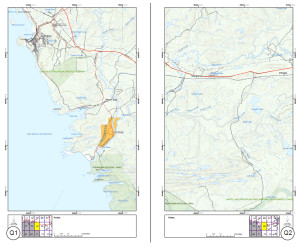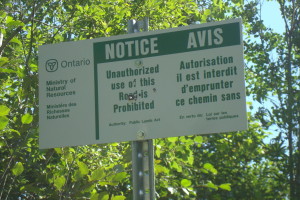Mapping the “Sufficient, Continuous and Exclusive” Tests
It’s been over a year since the Supreme Court of Canada’s unanimous ruling on the Tsilhqot’in Case. When I read the decision, the words of Chief Justice Beverley McLachlin jumped off the page. In describing the test for Aboriginal title, she stated that it [occupation] “must be sufficient; continuous (where present occupation is relied on); and it must be exclusive” (para 25). As a land use planner and cartographer, these words were read as a challenge.
Thinking about the communities where I work, many of whom are in the comprehensive claims process, I wondered what research products would be needed to meet these three tests. Once this research was assembled, could we reach a reconciliation of title and avoid the Crown’s policy of extinguishment?
I’ve been working for almost 20 years on Aboriginal land management issues with a wide range of experts throughout Canada, on various pieces of land claims research. But I haven’t come across a single published study that outlines the must-have shopping list of research products to help in title determination.
I recently spoke with a mentor of mine, Dr. Doug Elias, and asked him specifically about this. He had a lot to say on the topic. Dr. Elias, retired professor in the Faculty of Management at the University of Lethbridge, Alberta, has worked on Aboriginal title issues across Canada since the late 1960’s.
Elias told me that the three tests have been around since the 1980’s when the Baker Lake ruling was decided. But the research needed to meet these tests has been quickly evolving. He published a paper on the topic for the Ontario Model Forests in 2002 – which served as a good primer to get me started. It’s a bit outdated, but certainly worth the read (need to click on the “click here to view” link on their site).
In our conversation, Elias first advised me not to oversimplify the onerous task in meeting these tests. “A mountain of research is needed”, he said. This, despite Chief Justice McEachern in Delgamuukw cautioning that “there are limits to how much evidence a party may adduce, and a trial must always be confined within reasonable limits.” Elias noted that research needs to be tailored to each community on a case-by-case basis. But there are some overarching or core research pieces that should be quite common between cases. And many research products can be used to address more than one of the three tests. Here’s a summary and a few notes for each:
1. Use and Occupancy Study
A good use and occupancy study might be one of the most important pieces of research to address the three tests. These studies carefully map out where harvesting of plants and animals take place, where there are habitations and fixed cultural sites and where trapping and cultural activities occur within a harvester’s living-memory. When done well, these studies demonstrate, in a very defensible way, where and how the land is being used. A great resource for these studies is Living Proof by Terry Tobias. These studies can also be tweaked to incorporate a time element to capture frequency of use (how often, when, etc.), and changing patterns of use over time, which may prove helpful in dealing with the sufficiency test. But mapping intensity and change of use can be expensive and a very complex undertaking. See for example the Subsistence Mapping of Nuiqsut, Kaktovik and Barrow study for what might be involved in designing a study to document subsistence patterns and measuring changes in those patterns over time.
2. Harvest Study
While a use and occupancy study demonstrates where and how the land is being used, a harvest study answers the question, how much is being used? In simple terms, these studies track seasonal harvesting amounts on a house-by-house basis and convert pounds of meat, berries, firewood, etc. into current market values. Of all the studies, the harvest study might prove to be the most time intensive and difficult to complete. I believe, however, that a rapid-appraisal technique can be used to approximate harvest amounts, producing enough information to help move forward in dealing with the sufficiency test. Research results can also be used when negotiating impact benefit agreements or when developing mitigation strategies to address the displacement of harvesters.
3. Toponym or Place-Name Study
Naming places is an act of claiming sovereignty, a key reason why the Crown almost entirely deleted or replaced Aboriginal place names from Canada’s topographic maps. Peter Di Gangi, consultant and Director of Policy and Research with the Algonquin Nation Secretariat (ANS), has documented Quebec’s “Toponymical Imperialism” between 1911 and 1928 where Quebec’s Geographic Names Commission removed “barbarous” indigenous place names and replaced them with “cultured” French toponyms. I’ve since worked with the ANS to build a tool to help put Algonquin names back on their maps through a site titled, The Land that Talks .
But naming places is more than just an act of planting flags. Indigenous place-names can help to document kinship and family connections to the land and reveal a profound understanding of local ecology which is important in all three tests of title.
4. Indigenous Knowledge (IK) or Traditional Ecological Knowledge (TEK) Studies
This is a tough piece of research. When done well, these studies can help to document sufficiency and continuity of title by demonstrating deep knowledge of place, based on experience, oral history and cultural traditions. TEK research is helpful to predict outcomes of change: how, for example, will animal behavior change given a specific change in the environment (mine, oil sands, climate change, etc.). It can also help to document laws or code of ethics in managing resources, all important for the sufficiency determination.
But these studies are difficult to pull off, or pull off well. In a recent conversation with Terry Tobias, author of Living Proof, Terry noted that very few TEK studies published in Canada have documented their methods and that most studies have produced questionable results when it comes down to the reliability or replicability of their findings. Elias agrees. He said that, despite just about every land and wildlife program in Canada incorporating traditional knowledge in their policy statements, these organizations have very little to say about best practices in how to do so. “Platitudes without practice”. You can see this with Ontario’s Moose Management Policy or Canada’s Species at Risk Act.
A good recent resource on the subject is a report by Peter Armitage and Stephen Kilburn, titled Conduct of Traditional Knowledge Research in the Inuvialuit Settlement Region. One of the guiding principles from this report in designing a TEK or IK study is to “use proper social science research methods, set clear research objectives and restrict research topics so these can be achieved in the time and with the resources available”. Good advice.
5. Documentation of Customary and Traditional Laws
The courts have asked claimants to make their “Aboriginal systems of governance” and laws known. Elias notes that there are no real best-practices in this field of study but skilled ethnographers should have no problem in pulling this research together. The outcomes from this research will not only help with the sufficiency determination for title, but can also be used for joint or co-management negotiations governing how lands are managed.
6. Archaeology, written history and ethnography
This might be the most straight forward research component, but may entail the most amount of work. Elias describes this work as a way to summarize all available research into a narrative that demonstrates the extent of a claimant’s territory since the time of contact (and before), the extent of exclusivity and overlap with neighbours, and a record of the claimants’ changing social environment. The research also demonstrate that the claimant is an ‘organized society’ and that this society is connected to land. Pretty much all three tests of title will rely on the narrative from this research.
7. Genealogy
Genealogy studies can fall under general ethnographic research, but I’ve separated it out here because it should be tackled as a stand-alone piece of research. These studies start by asking, “who are today’s members?” and work backwards from there. This helps to demonstrate the degree to which the community has maintained its continuity of membership over time. This is important for the continuity and sufficiency tests. According to Peter Di Gangi, this research is very powerful when connected to the use and occupancy research to demonstrate continuity of use.
8. Alienation Study and State of the Territory Report
I added this to the list based on my own experience in working on land issues. White spaces on maps are often interpreted as “abandoned” or “surrendered”. Once we inventory third party use and cumulative impacts in a territory, however, we get a clearer sense of why harvesters may have gone elsewhere (e.g. mining, forest development, aggregates, oil and gas, Crown dispositions, non-native harvesting and tourism, etc.). These studies are also important in negotiating interim relief while Title is being resolved. And these studies can help in determining compensation for impacts.
____
From this list we can clearly see that mapping is a central tool to record, package and tell the story of Aboriginal Title. We can also see that whenever a wealth of information is collected, information management standards are needed to organize and safeguard the research products. And of course, good research doesn’t speak for itself – it needs to find its way into the hands of a strong leadership, skilled negotiators and experienced legal advisors.
And what about a budget and timeline to pull all of this research together? I might go out on a limb here. With some legal time thrown into the mix, I would hazard to guess that it would be around $750,000 to $1,000,000 and a minimum of three to five years to pull together, depending on the community and complexity of the case. This could certainly be more if a full harvest study is undertaken, not just a rapid appraisal study. Either way, this is a significant investment, especially when the outcomes for title determination aren’t guaranteed.
But if done well, these research products can be used for other applications like helping to inform consultation and accommodation work with the Crown. And for education, cultural rediscovery and outreach. This alone to me is a good return on investment.
-David Carruthers, BES, MSc, MCIP, RPP



